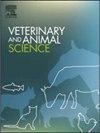Injection site abscesses associated with commensal and environmental bacteria following intramuscular vaccination in horses
IF 1.9
Q2 AGRICULTURE, DAIRY & ANIMAL SCIENCE
引用次数: 0
Abstract
Five previously healthy horses in Korea, including a 19-year-old mixed-breed gelding, a 16-year-old mixed-breed mare, a 13-year-old Thoroughbred gelding, a 12-year-old Belgian warmblood mare, and a 12-year-old Andalusian mare, developed subcutaneous abscesses in the left neck after receiving intramuscular vaccination without prior skin disinfection. The vaccination used was Equivac® 2 in1, containing Clostridium tetani toxoid and Streptococcus equi cell-free extract.
Within one week, the horses developed localised swelling and/or abscessation at the injection site. One case involved a ruptured abscess, while the others presented with warm, mildly painful, and non-fluctuant swellings. No foreign bodies were palpable at the injection sites.
Both aerobic and anaerobic bacterial cultures were performed using 5 % defibrinated sheep blood agar, and the isolates were identified as Bacillus cereus, Corynebacterium glutamicum, Aerococcus viridans, Acinetobacter pseudolwoffii, Arthrobacter koreensis, and Paenarthrobacter aurescens, all of which were consistent with commensal or environmental flora. PCR testing was negative for Streptococcus equi.
In this cohort, post-injection abscesses occurred in 5 out of 70 horses (7.1 %) and were associated with commensal and environmental bacterial species, suggesting these cases likely resulted from procedural lapses rather than a direct vaccine-related reaction. Although the benefit of alcohol swabbing is debated in human medicine, this practice may offer important benefits under variable hygienic conditions in equine field settings. Accordingly, disinfecting the injection site with an alcohol- or disinfectant-soaked swab should be considered a routine precaution to minimise post-injection complications in horses.
马肌肉注射后与共生细菌和环境细菌有关的注射部位脓肿
19岁的杂交母马、16岁的杂交母马、13岁的纯种母马、12岁的比利时温血母马、12岁的安达卢西亚母马等5匹健康的马在没有事先进行皮肤消毒的情况下接受肌肉注射疫苗后,出现了左颈部皮下脓肿。使用的疫苗是Equivac®2 in1,含有破伤风梭菌类毒素和马链球菌无细胞提取物。在一周内,马在注射部位出现局部肿胀和/或脓肿。一个病例涉及破裂的脓肿,而其他表现为温热,轻度疼痛,无波动的肿胀。注射部位未见异物。采用5%去纤羊血琼脂进行好氧和厌氧细菌培养,分离菌株鉴定为蜡样芽孢杆菌、谷氨酸棒状杆菌、绿质航空球菌、假假woffii不动杆菌、高丽节杆菌和aurecenpaenarthrobacter,均与共生菌群或环境菌群一致。PCR检测结果为马链球菌阴性。在这个队列中,70匹马中有5匹(7.1%)发生了注射后脓肿,并且与共生和环境细菌种类有关,这表明这些病例可能是由于程序失误而不是直接与疫苗相关的反应。尽管人类医学对酒精擦拭的益处存在争议,但在马场环境中,这种做法可能在各种卫生条件下提供重要益处。因此,应将用酒精或消毒剂浸泡的棉签对注射部位进行消毒视为常规预防措施,以尽量减少马注射后并发症。
本文章由计算机程序翻译,如有差异,请以英文原文为准。
求助全文
约1分钟内获得全文
求助全文
来源期刊

Veterinary and Animal Science
Veterinary-Veterinary (all)
CiteScore
3.50
自引率
0.00%
发文量
43
审稿时长
47 days
 求助内容:
求助内容: 应助结果提醒方式:
应助结果提醒方式:


